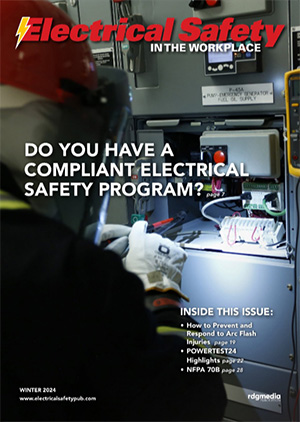Do You Have a Compliant Electrical Safety Program?
How to develop, implement and maintain a compliant ESP.
By: Terry Becker, P.Eng., CESCP, IEEE Senior Member
The purpose and contents of a compliant Electrical Safety Program (ESP) are widely misunderstood in industry. However, an effective ESP can save lives by eliminating or reducing the risk of exposure to electrical hazards at a worksite, and a compliant ESP ensures employers have required electrical safety policies, practices, processes and procedures in place, and that they can be enforced.
It is important to know the answers to these questions:
- Which electrical safety standards provide guidance for ESP development?
- What is in a compliant ESP? And, do you have a compliant ESP?
- Who manages the ESP?
- How should I develop an ESP?
- Who manages and implements the ESP?
- Why do I need to maintain a compliant ESP?
WHICH ELECTRICAL SAFETY STANDARDS PROVIDE ESP GUIDANCE?
Electrical safety standards in the U.S. and Canada provide ESP guidance, including:
- NFPA 70E Article 110 General Requirements for Electrical Safety-Related Work Practices and Article 110.5 Electrical Safety Program
- CSA Z462 Clause 4.1 General Requirements for Electrical Safety-Related Work Practices and Procedures and Clause 4.1.5 Electrical Safety Program
When we review NFPA 70E Article 110.5 Electrical Safety Program and CSA Z462 Clause 4.1.5 Electrical Safety Program; we are provided high level information on structurally what information the ESP may contain as content.
Some specific examples of the information and content in an ESP are also provided in NFPA 70E or CSA Z462 Annex E Electrical Safety Program.
However, NFPA 70E and CSA Z462 are not Electrical Safety Programs, they are Standards! A compliant ESP should include specific content defined by these Standards, such as:
- NFPA 70E Article 105 Application of Safety-Related Work Practices and Procedures and Article 110 General Requirements for Electrical Safety-Related Work Practices and CSA Z462 Clause 4.0 Safety-Related Work Practices
- NFPA 70E Article 120 Establishing an Electrical Safety Work Condition or CSA Z462 Clause 4.2 Establishing an Electrical Safety Work Condition
- NFPA 70E Article 130 Work Involving Electrical Hazards or CSA Z462 Clause 4.3 Work Involving Electrical Hazards
- NFPA 70E Chapter 2 and Chapter 3 and CSA Z462 Clause 5 and Clause 6 also provide some supporting information, but no specific requirements of the content of an ESP.
- The Annexes provide general and supporting information related to NFPA 70E Chapters and Articles or CSA Z462 Clauses. The information is informative, except for CSA Z462 Annex V Arc Flash PPE Selection Table Method.
However, the information provided in NFPA 70E and CSA Z462 with respect to an ESP doesn’t constitute the “framework” of a complete and comprehensive Occupational Health & Safety Management System (OHSMS); which is actually what an ESP is, specific to the electrical hazards of arc flash and electric shock.
WHICH OCCUPATIONAL HEALTH AND SAFETY STANDARDS PROVIDE ESP GUIDANCE?

An ESP provides the best due diligence to comply with OSHA safety requirements in the United States, and OH&S regulations in Canada. Image courtesy of TW Becker Electrical Safety Consulting Inc., www.twbesc.ca.
It is also imperative to comply with Occupational Health & Safety Management System Standards such as ANSI Z10 for the United States or CSA Z45001 for Canada (Canada adopted ISO 45001). In the U.S., OSHA provides high level guidance related to safety management systems on their website and a PDF reference guide: https://www.osha.gov/safety-management, “Recommended Practices for Safety and Health Programs” in the workplace or related to construction.
In Canada we can also consider the recommendations made by Provincial or Territorial Governments on the Certification of Recognition (COR) “framework” they may recommend. In the Province of Ontario the Infrastructure Health & Safety Association (IHSA) provides detailed information and does outline a recommended framework for an OHSMS, https://www.ihsa.ca/cor/cor2020. CSA Z462, Annex A also provides a high-level correlation between content in CSA Z462 and the requirements of CSA Z45001 (e.g. ISO 45001) Occupational Health & Safety Management Systems.
OSHA also provides the ability to work more closely with them, similar to the Canadian COR process, via OSHA’s Voluntary Protection Program (VPP) https://www.osha.gov/vpp/ . The VPP would be more applicable to large corporations.
According to OSHA, VPP recognizes employers and workers in the private industry and federal agencies who have implemented effective safety and health management systems and maintain injury and illness rates below national Bureau of Labor Statistics averages for their respective industries. In VPP, management, labor, and OSHA work cooperatively and proactively to prevent fatalities, injuries and illnesses through a system focused on: hazard prevention and control; worksite analysis; training; and management commitment and worker involvement.
To participate, employers must submit an application to OSHA and undergo a rigorous onsite evaluation by a team of safety and health professionals. VPP participants are also exempt from OSHA programmed inspections while they maintain their VPP status.
WHAT IS IN A COMPLIANT ESP?
Based on NFPA 70E or CSA Z462 the following content needs to be included in an ESP main document and related documentation (e.g., appendices, forms, flow charts, checklists, infographics, procedures, etc.).
- Scope
- Policy
- Roles & Responsibilities
- Establishing an Electrically Safe Work Condition
- Justification for Energized Electrical Work
- Normal Operating/Equipment Conditions
- Safe Installations
- Electrical Equipment Maintenance Consideration
- Risk Assessment Procedure
- Hierarchy or Risk Control Methods
- Electrical Incident Emergency Response
- Electrical Incident Investigations
- Separate Lock Out Tag Out (LOTO) Program
- Auditing
- Training
- Qualified Person
- Unqualified Person
- Test Instruments
- Portable Cord-and-Plug-Connected Electrical Equipment
- GFCIs
- Energized Electrical Work Permit (EEWP) Policy with Exemptions
- Shock Risk Assessment
- Arc Flash Risk Assessment
- Arc Flash and Electric Shock PPE, Tools and Equipment
- Other Precautions for Electrical Safety
HOW TO DEVELOP AN ELECTRICAL SAFETY PROGRAM
Developing an ESP is not complicated if you review and interpret information reasonably, and create a plan to develop, implement and maintain your ESP. Ultimately an ESP needs to be a full or comprehensive “toolbox” for management, safety, engineering, supervision, qualified persons and unqualified persons when they need to know how arc flash and electric shock hazards will be managed at the employer’s worksite, related to assigned jobs and the related work task(s) to execute the requirements of the job.
The ESP also provides additional documentation tools to ensure the required Risk Assessment Procedure is documented and that assumptions made in determining the work task’s risk level are field verified by the Qualified Person.
The ESP’s table of contents should flow information presentation in a logical manner and ultimately be a resource for the identification and implementation of preventive and protective risk control methods applied to the qualitative Risk Assessment Procedure (RAP) that is completed by the employer.
HOW TO MANAGE AND IMPLEMENT AN ELECTRICAL SAFETY PROGRAM
Assign an Electrical Safety Program Manager and constitute an Electrical Safety Committee (ESC) at your worksite. The ESC may be two people or twenty. Get organized and identify a Project Execution Plan for the ESP development and implementation. Schedule ESC review meetings and establish a project schedule, planning three to six months for development, and then a timeline to transition the ESP into use before it is fully enforceable.
Plan for management approval and ESP Roll Out Orientation Training (ROOT), and a process and timeline for transitioning to the application of the policies, processes and practices, as well as procedures for the implementation of field-based documentation the ESP will require, such as the Energized Electrical Job Safety Planning (EEJSP) form and Energized Electrical Work Permit (EEWP).
WHY DO YOU NEED TO MAINTAIN A COMPLIANT ELECTRICAL SAFETY PROGRAM?
An ESP provides the best due diligence to comply with OSHA requirements in the U.S. and OH&S regulations in Canada. It ensures the employer has in place required policies, practices, processes and procedures that can be enforced. It also provides specific direction to your workers, and it provides documented proof in the field that your company is applying NFPA 70E or CSA Z462, and that your workers are applying the arc flash and electric shock training they receive. It will also help you control the related costs of preventive and protective risk control methods implemented.
For example, when an Internal Electrical Safety Audit requirement is included, it will lead to sustainable and measurable performance. Ultimately, the ESP is used to save lives and eliminate or reduce risk of exposure to electrical hazards to as low as reasonably practicable.
Provide your workers confidence and certainty and put them in control of their personal safety! TAKE CONTROL of ARC FLASH!
Get started or update or replace what you have developed to date! An ESP is actually the first thing you should do with respect to arc flash and electric shock hazards in the workplace. ESW
If you are interested in discussing the information presented in this article or would like a specific topic presented in a future article do not hesitate to contact the author at terry.becker@twbesc.ca or 587-433-3777. Terry Becker, P.Eng., CESCP, IEEE Senior Member, is a founding member and the First Past Vice-Chair of the CSA Z462 Workplace Electrical Safety Standard Technical Committee, and currently a voting member and Clause 4.1 and Annexes Working Group Leader. Terry is also a founding member and voting member on the CSA Z463 Maintenance of Electrical Systems Standard and a voting member of the IEEE 1584 Guide for Performing for Arc-Flash Hazard Calculations. He has presented at conferences and workshops on electrical safety in the U.S., India, Australia, Italy and Canada, and is a professional engineer in the Canadian Provinces of BC, AB, ON and PEI.
Share on Socials!
NFPA 70E® 2021 for Electrical Safety in the Workplace®
Electrical Safety Finds Its North Star
Six Keys to NFPA 70E® Training
Leaders in Electrical Safety
• Aramark
• Bowtie Engineering
• Enespro
• Ericson
• I-Gard Corporation
• IRISS
• KERMEL, INC.
• Lakeland Industries
• MELTRIC Corporation
• National Safety Apparel
• National Technology Transfer
• Oberon
• Saf-T-Gard
• SEAM Group
Subscribe!
Sign up to receive our industry publications for FREE!








